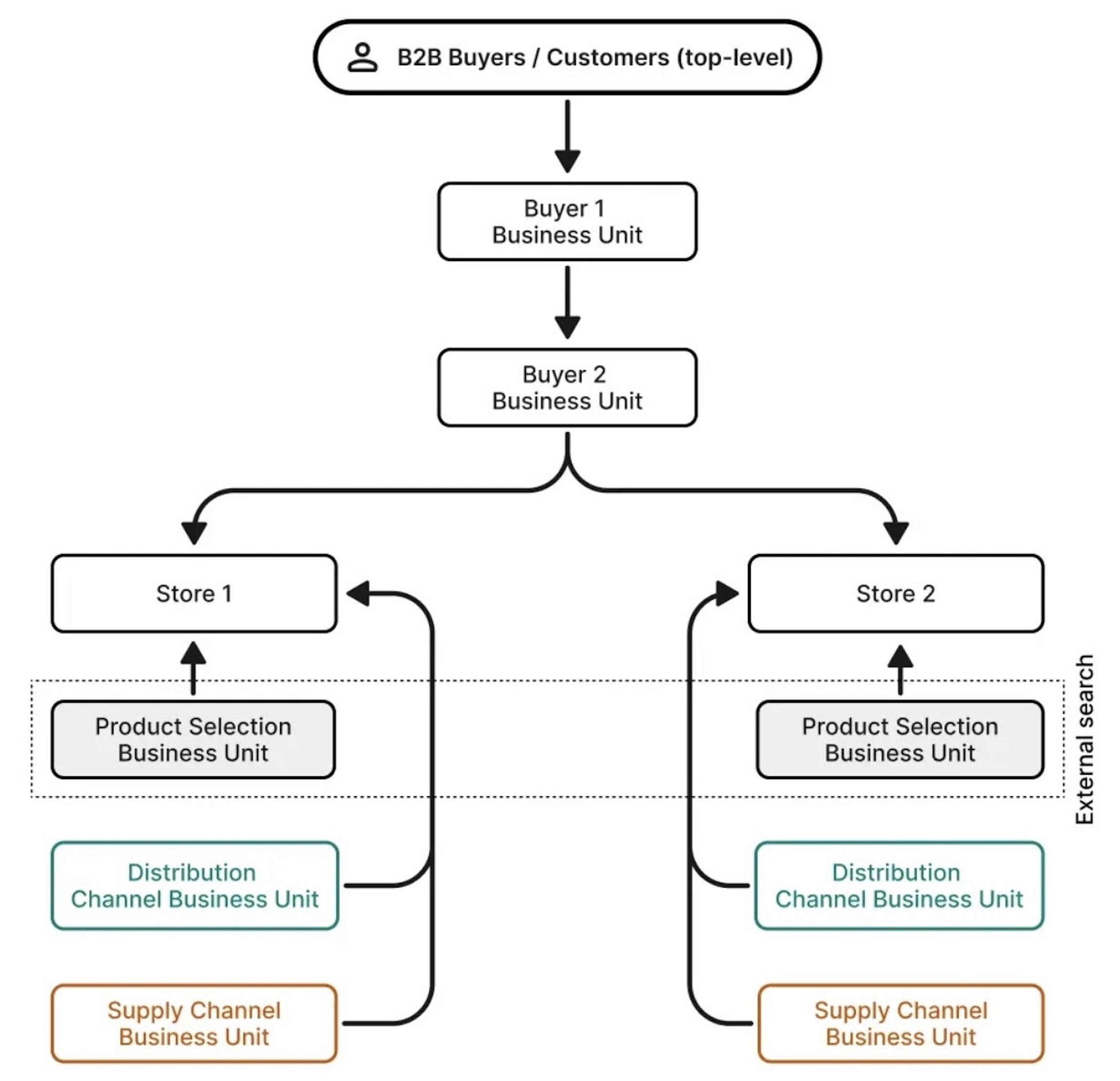
Customer-specific product catalogs, pricing and promotions have long been the backbone of B2B commerce, reflecting the relationship-driven nature of business buying. But how can manufacturers, distributors and wholesalers replicate this level of customization in enterprise eCommerce — and manage the complexity that comes with it? That’s where commercetools comes in.

Scaling B2B customization in eCommerce
B2B transactions are far from simple. Unlike the uniform pricing and straightforward purchase journeys common in B2C commerce, B2B buying typically involves multiple stakeholders, large order volumes and intricate workflows.
B2B sales in such complex scenarios often involve intense negotiations on volume pricing and custom entitlements, which can set the tone for long-term, profitable relationships. That makes customization a core pillar of B2B commerce. Indeed, 64% of B2B buyers expect suppliers to provide tailored digital products. Typical customer-specific capabilities include:
Personalized catalogs: Tailored product assortments help buyers find relevant items faster, improving both efficiency and user satisfaction.
Custom pricing: Reflecting negotiated terms, volume discounts or loyalty tiers reinforces trust and strengthens commercial relationships.
Targeted promotions: Personalized promotions based on purchase history or customer profile increase engagement and incentivize repeat purchases.
Negotiated discounts on minimum order quantity (MOQ): Enable pricing negotiation on bulk orders or when buying on a purchase order commitment.
Entitlements: Restricting access to specific products, services or pricing based on contracts, roles or regulations ensures compliance and streamlines the buying experience.
Historically, B2B firms excelled at hyper-customized sales orchestrated by sales representatives and executed through many manual processes, often involving fax and phone calls. But today’s B2B organizations are more complex than ever, spanning continents and business models, as well as expanding product catalogs. This growing complexity makes it impossible to scale customization through manual efforts alone. To meet modern demands, digitization and automation are essential for delivering tailored experiences efficiently and at scale.
Providing eCommerce experiences with a customized approach is table stakes, as B2B organizations can’t provide an effective digital experience to their customers without showing the right pricing, products and discounts that their customers already have. Otherwise, the digital experience does not reflect reality. The benefits are many:
Stronger relationships and long-term value: Tailored catalogs, pricing and promotions demonstrate deep customer understanding, strengthen loyalty and support negotiated contracts and volume discounts.
Higher sales and efficiency: Correctly customized experiences reduce friction, show only relevant products and pricing, speed up decision-making and minimize reliance on sales reps.
Operational excellence Automated entitlement checks and dynamic pricing reduce errors, support compliance, streamline ordering and reduce friction — critical for complex B2B needs.
Predictable margins and revenue: Granular pricing control and targeted discounts protect profitability, while data from personalized interactions improves segmentation and forecasting.
Competitive differentiation: A tailored, seamless digital experience is about meeting modern B2B buyers on whatever channel they choose, whether via a sales rep or online. Empowering buyers to self-serve when it’s convenient for them, essentially enabling an omnichannel experience, helps businesses outpace the competition.
As the B2B sector accelerates its shift toward digital, providing this level of customization in experiences is becoming a powerful differentiator. But doing it right requires the right tools. Enter commercetools.
Customer-specific commerce: How commercetools does it
With commercetools, B2B commerce starts with the concept of Business Units (BUs), which are logical representations of a buying organization’s structure, such as departments, subsidiaries or regional locations.
Depending on the complexity of your organization, you might have a single BU (e.g., one company = one BU) or operate at scale with hundreds or even thousands of BUs. For instance, a hospital chain may have separate BUs for each department or location, each responsible for its own procurement of medical equipment and supplies.
Within each BU, you can define Associates — users involved in the buying process — with specific roles like buyer, reviewer or approver. Each associate’s permissions can be customized to fit your business’ specific governance needs. Some associates may span multiple BUs (e.g., a procurement head approving purchases across the entire organization), while others operate only within a single BU.
Once this foundation is in place, you can configure dedicated product catalogs, pricing, promotions and entitlements for each BU based on pre-negotiated contracts or customer-specific terms. That means a single company can have hundreds of tailored catalogs, all managed centrally, with each associate seeing only what they’re authorized to see.
The key to managing this complexity lies in the concept of Stores. This powerful commercetools feature allows you to maintain master data (customers, products, pricing, etc.) in a unified platform and create logical groupings tailored to specific contexts (in this case, the Business Unit). It allows you to:
Localize content and language.
Apply BU-specific product catalogs, pricing and promotion strategies.
Control visibility at a granular level per customer or segment.
Override settings by channel, region or business division to accommodate unique needs.

In a nutshell, commercetools offers B2B companies, no matter their size or complexity, enterprise-scale customization at top-notch performance and scalability guaranteed through SLAs.
Customer groups: A personalization layer
In addition to Business Units and account-specific pricing, Customer Groups offer another way to segment your customer base and deliver personalized experiences. While this concept is commonly used in B2C (e.g., grouping customers to offer special pricing), it also has powerful applications in B2B.
For example, it’s possible to create a customer group for companies located in a certain region and offer a discount. This layer of personalization isn’t tied to company hierarchies or formal contracts but rather to broader B2C-like segmentation, such as geography, industry or buyer behavior.
This represents a personalization layer, ideal for scenarios where you want to apply consistent pricing or promotions across a segment that spans multiple Business Units.
Customizing what you need with the Merchant Center
The commercetools Merchant Center provides a no-code user interface where merchants can directly manage and configure all their B2B settings with ease. Teams can fully manage their commercetools project, including:
Customize product catalogs per business customer by adding or removing specific products, or even by tailoring the product data to a given customer or market.
Set customer-specific pricing for each product.
Define tailored discounts and promotions per account.
All of this can be done natively within the Merchant Center — no custom development required.
Thanks to granular seller-side permissions, different team members can be assigned specific responsibilities. For example, one team might manage pricing, while another oversees catalog visibility or discounts. These permission controls help reduce operational risk, ensure compliance and eliminate surprises for both sellers and buyers.
Tracking all the data you need with Audit Log
The Audit Log is a powerful tool for maintaining transparency and accountability in B2B transactions. It allows you to track exactly who made changes, what was changed and when, down to the most granular actions like updating a product price or modifying discount terms.
For example, if a dispute arises over pricing, the Audit Log makes it easy to identify that a user changed the price of a specific product on a specific date. This clarity helps resolve issues quickly and fairly, by showing the origin of the change.
Having this level of transparency is a core requirement for many B2B organizations in regulated industries and/or selling complex products, such as medical devices, radiation safety equipment, chemicals, etc.
commercetools provides two versions of Audit Log: Basic and Premium. Check the differences and see which version best applies to your requirements.
Real-world examples across B2B industries
Customer-specific catalogs, pricing and promotions are used across a wide range of industries, from healthcare and food service to industrial manufacturing and office supplies, where tailored buying experiences are essential to meet the unique needs of each customer segment. Let’s explore a few examples.
Cargo Crew, a leading Australian workwear company, enables B2B buyers to browse, customize and order work uniforms in a tailored fashion. Cargo Crew started to build custom B2B websites dedicated to strategic clients to streamline the complex uniform supply chain process and facilitate easy 24/7 ordering of curated uniform ranges, including categories, images, pricing and catalog. This tailored site enables clients to purchase uniforms in bulk and personalize products with embroidery, monograms, emojis and logos.
To support this high level of personalization, Cargo Crew modeled Business Units within their commerce architecture to configure product visibility, pricing and customization options to reflect the needs of each buyer organization. This approach also ensures that every user within a client’s organization sees only the products relevant to them. This scalable model not only simplifies uniform management for large clients but also reinforces long-term customer relationships through a tailored, self-service digital experience.
Paul Rodgers, Co-Founder and Operations Director, said, “We have created scale within our business by being able to quickly launch and customize a web of eCommerce sites across our complex business.”
The flexible configuration of Business Units provides benefits for the food industry. Lallemand, a global leader in the development and production of yeast, bacteria and specialty ingredients, has embarked on a digital transformation journey to enhance its B2B commerce capabilities. The company initiated this transformation with its baking business unit in North America, laying the groundwork for broader expansion across additional use cases, touchpoints, regions and business units.
As part of this effort, Lallemand has implemented a customer-specific pricing model: Customers can view the full product catalog, but prices are only visible for products they have previously purchased. If the buyer expresses interest, the system triggers a conversation with a sales representative for products they have not yet bought. Given the complexity of Lallemand’s product offerings, this approach ensures customers receive tailored guidance, such as selecting the appropriate yeast and complementary ingredients for specific baking outcomes like fluffy croissants. Once the customer’s needs are fully understood, the sales team can reveal pricing and facilitate the purchase either through the representative or directly via the digital portal.
Another example is Dawn Foods, an American B2B manufacturer and distributor of bakery ingredients and baked goods. To manage the complexity of serving various bakery segments, such as those specializing in cupcakes, pastries or breads, Dawn Foods uses Business Units within its commerce platform. This allows the company to tailor product catalogs, pricing and promotions to the specific needs of each group. This granular approach ensures that customers see only the most relevant products and content, enhancing their purchasing experience.
Start delivering what your customers need with commercetools
By leveraging the flexibility of Business Units, commercetools enables manufacturers, wholesalers and distributors to replicate customer-specific products, pricing, promotions and entitlements in a digital environment — securely, efficiently and at enterprise scale.
